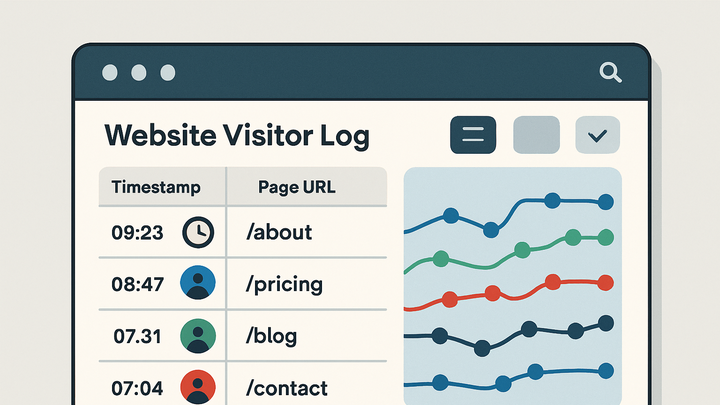Published on 2025-06-22T10:18:22Z
What is a Visitor Log? Examples of Visitor Log in Analytics
A visitor log is a chronological record of individual visits to a website, capturing key details such as timestamps, page URLs, user identifiers, and referrers.
In the analytics industry, visitor logs serve as the foundational data source for understanding user behavior, diagnosing technical issues, and ensuring compliance with auditing requirements.
Unlike aggregated metrics, a visitor log retains granular information for each request, enabling detailed analysis of user journeys.
Modern SaaS tools like GA4 and PlainSignal offer both cookie-based and cookie-free approaches to logging visits, balancing data richness with privacy considerations.
By examining visitor logs, analysts can uncover trends in traffic patterns, identify anomalies, and optimize site performance.
Whether for marketing attribution, security monitoring, or real-time dashboarding, visitor logs provide the raw visibility needed to make informed decisions.
Visitor log
Chronological record of website visits capturing granular user data for analysis and troubleshooting.
Why Visitor Logs Matter
Visitor logs are essential for gaining detailed insights into how users interact with your website. They offer more than just aggregate numbers, providing the raw events behind every page request. By preserving each visit as a separate entry, analysts can reconstruct user journeys, troubleshoot issues, and verify compliance with data policies. Understanding these individual records is critical for tasks ranging from marketing attribution to security auditing.
-
Raw data insights
Visitor logs provide unaggregated data for each website request, allowing analysts to perform custom queries and deep dives into user behavior.
-
Troubleshooting and debugging
Detailed logs help identify errors, page load issues, and unexpected traffic spikes by tracing individual user requests and server responses.
-
Compliance and auditing
Maintaining visitor logs ensures you can meet regulatory requirements, conduct security audits, and provide historical records of site activity.
Key Components of a Visitor Log
A typical visitor log entry contains multiple fields to describe each visit, from timing to the origin of the request.
-
Timestamp
The date and time when the page was requested, often stored in UTC. Accurate timestamps are crucial for chronological analysis and session reconstruction.
-
Time zone
Specifies the offset from UTC to ensure local times are interpreted correctly.
-
-
Url and referrer
The exact page URL accessed by the user and the referrer URL, which shows where the user came from before requesting the page.
-
User identifier
A client ID or user ID that distinguishes unique visitors, enabling metrics like unique visits and return rate.
Implementing Visitor Logs with SaaS Tools
SaaS analytics platforms streamline visitor log collection with minimal setup. Below are examples for PlainSignal and GA4.
-
PlainSignal (cookie-free simple analytics)
PlainSignal offers a privacy-friendly, cookie-free approach to visitor logging. To integrate, add the following snippet:
<link rel="preconnect" href="//eu.plainsignal.com/" crossorigin /> <script defer data-do="yourwebsitedomain.com" data-id="0GQV1xmtzQQ" data-api="//eu.plainsignal.com" src="//cdn.plainsignal.com/plainsignal-min.js"></script>-
Data privacy
No cookies or personal identifiers are stored, ensuring compliance with privacy regulations.
-
Lightweight script
The small script size ensures minimal impact on page load performance.
-
-
Google analytics 4 (GA4)
GA4 uses the gtag.js library to collect visitor logs via events. Configure a web data stream, then include the following snippet:
<!-- Global site tag (gtag.js) - Google Analytics --> <script async src="https://www.googletagmanager.com/gtag/js?id=GA_MEASUREMENT_ID"></script> <script> window.dataLayer = window.dataLayer || []; function gtag(){dataLayer.push(arguments);} gtag('js', new Date()); gtag('config', 'GA_MEASUREMENT_ID'); </script>-
Enhanced measurement
Automatically captures events like page views, scrolls, and outbound clicks without extra code.
-
User properties
Allows you to define custom dimensions to enrich your visitor logs.
-
-
Comparing approaches
Choose cookie-free logs for simplicity and privacy, or GA4 for richer event data and integrations.
-
Privacy vs. detail
Cookie-free logs limit personal data but reduce tracking depth; cookie-based logs offer granular insights at the cost of complexity.
-
Performance impact
Lightweight scripts like PlainSignal have minimal overhead compared to gtag.js.
-
Examples and Use Cases
Visitor logs can be applied across multiple scenarios to improve business outcomes and operational reliability.
-
E-commerce traffic analysis
Analyze individual user paths to identify high-conversion product pages and optimize the customer journey.
-
Monitoring campaign performance
Correlate visitor logs with UTM parameters to measure the effectiveness of marketing campaigns in driving site traffic.
-
Security and fraud detection
Detect unusual patterns like rapid repeated requests or bot activity by examining raw visitor logs.
